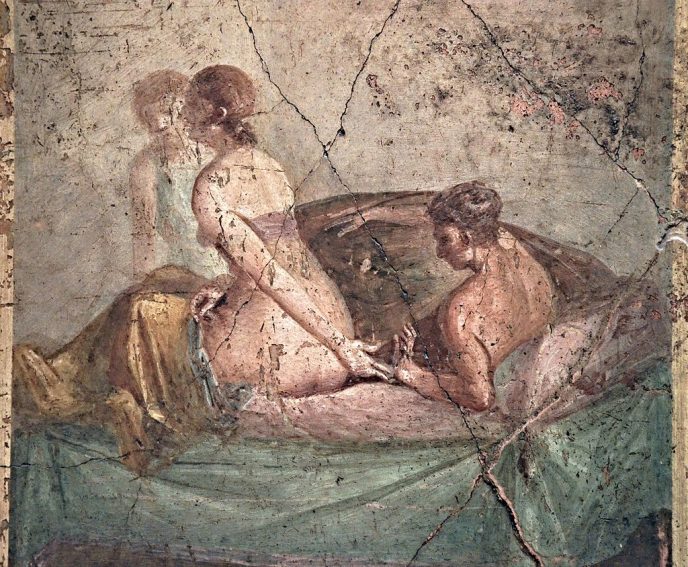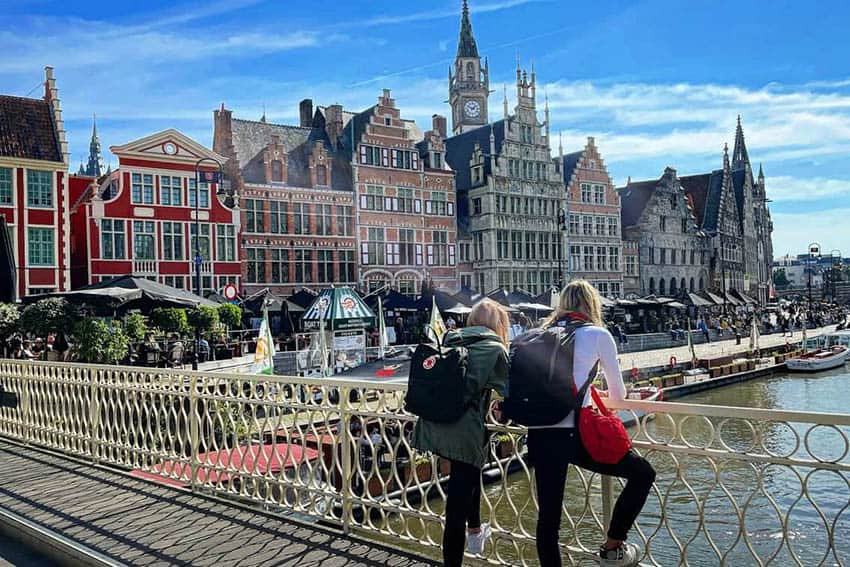
The Pompeii Eruption that Froze a Town
By Laura Stone
Adapted from her book Crossing the Mediterranean

On our last day in Rome, my husband Chad and I headed to the port of Civitavecchia. We were sailing from Italy to Italy.
Okay, more specifically, we would be going from Rome to Sorrento. I wasn’t that excited about the initial debarkation. That is until… I learned about the stone people of Pompeii.
I had heard of the Pompeii lover’s last kiss statue, and now I would see it for myself, in all its frozen glory.
Ancient Pompeii… A Happenin’ Place Blows Her Top
Apparently, Pompeii was the Las Vegas of the ancient world. It was a popular Roman vacation spot — the stomping grounds of the rich and famous. Ever since the sixth century B.C., the who’s who of Italy felt that they had to build a house on the Strip. Er, I mean on Main Street, Pompeii.
| A Visit to Ostia Antica, Roman Ghost Town |
As a result, the city is filled with mosaics, frescos, pottery, functioning kitchens, and all the other fine things of the day.
About 20,000 inhabitants enjoyed a food market, a bar, many restaurants, several theaters, a gymnasium, aqueducts, baths, and even a hotel.
Then, in 79 A.D. the sky came crashing down on them. Mount Vesuvius blew her top and buried everything under sixty feet of ash and pumice. The city was abandoned and eventually forgotten. Not until the mid-1700s was the town rediscovered through excavations.
Unearthing the Lost City: The Big Discovery

Fortunately, buildings and personal belongings remained remarkably preserved, without deterioration from air and moisture, over those nearly 2,000 years. Yes, this was all fascinating, but it wasn’t the most interesting part.
Giuseppe Fiorelli’s Excavations
It was during these excavations that an archeologist by the name of Giuseppe Fiorelli started discovering empty areas within the digging sites and realized what these pockets were.
He had the brilliant idea of injecting plaster into the negative spaces to recreate the forms.
As a result, he was able to perfectly reproduce the poses of Pompeiian victims at the moment of their deaths. Effectively, he was filling the void left from their decomposed bodies. In many cases, their terror and anguish were evident, still etched across their faces. Wow!
This was the creepiest, yet most intriguing description I had ever heard. From that movement, I had to see the stone people of Pompeii. Unbelievably, no one told me that you would have to hire a guide to do this!
Traveling There was Only Half the Battle

Chad and I took a train to Pompeii. Things seemed to be going great. In fact, we had arrived so early that the place hadn’t yet opened.
So, we decided to take advantage of a nuclear lemon stand, where I downed the most flavorful icy of my life; it had been made from lemons the size of my head. Ahhh, I digress.
The point is that, once inside, I could not find the stone people. We walked down one cobblestone road after another.
I spied the chariot tracks worn into the surfaces of the streets. I recognized the remains of houses and businesses. There were large sections of colorful and detailed frescos that decorated the walls, depicting daily Roman life.
Ornate mosaics of designs, animals, and people sprawled across floors. There were massive stacks of pottery in every size and shape. Beautiful basins embellished kitchen counters. It seemed like it would have been a snazzy place to live. But, where were the remains of these former residents?
| Exploring the Art and Architecture of Pompeii |
I trekked up the hills and down the slopes, peeping into every nook. No stone people. After hours of searching, I was ready to give up. There were no signs. I had no map. No one knew where they were.
Some visitors, who spoke English, hadn’t even heard of them. My feet were sore and blistered. My legs ached. I was about to leave the site when I heard an encouraging phrase.
A Glimmer of Hope for Seeing the Stone People in Pompeii

“Through here are the casts of the human forms,” a tour guide was informing his group.
My attention perked like the ears of a watchdog. As nonchalantly as possible, I accompanied his followers through a side entrance, which struck me as purposefully hidden.
I meandered slowly through the shuffling crowd until I caught sight of the stone people. The view was eerily alluring — a terrible moment is frozen in history.
A Scene I Will Never Forget of Pompeii
The pale statues resembled artistic sculptures. A small boy bent over his knees and clutched his nose with both hands.

This posture must have been in an effort to breathe while being trapped alive in the raining debris. His mouth was open as if he had been screaming or crying.
There was also a pregnant woman, who lay belly down, covering her face. Her form, lonely and frightened, was a testament to human loss.
A dog’s contorted body appeared knot-like, with its legs lunged into the air and its head-hugging its backside, as though it had been strangled to death. The scene was severely grim.
The destruction of Pompeii sprung to life before my eyes. I could almost hear the people screaming, as I imagined the immobilizing fear that had gripped them during the volcanic rumbling and rain of ash. It became real to me.
How could something so painful have sparked my curiosity? At some point, the stone figures had ceased to represent actual people and become merely historical artifacts. Seeing them for myself allowed my imagination to breathe life into these human forms.
I had finally found the stone people… and now I would never forget them. Their anguish would be forever etched into my mind.

As a lifelong traveler, Laura Stone has trekked across five of the seven continents, with plans of visiting all seven — always nurturing her love of diversity. She has devoted her life to education, art, and cultural exploration. Graduating summa cum laude with a BA from Morehead State University in art and education, she went on to earn an MA in art education at the University of Cincinnati. She has written three travel books previously: I Give Seven Chicken, Americans in Brazil, and Crossing the Mediterranean.
Eurail Passes: What to Know about Buying a Europe Train Pass
- These 9 U.S. National Parks Require Reservations in 2024 - April 17, 2024
- Take a Hike in Olympic National Park - April 17, 2024
- The Wild Mississippi: 2340 Miles Across Ten States - April 8, 2024




